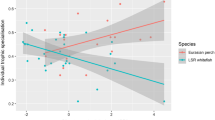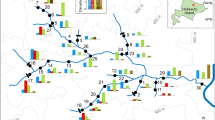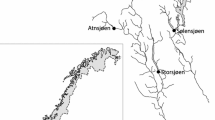Synopsis
Both historical patterns and recent evidence of resource partitioning and complementarity within the Lake Michigan fish community provide circumstantial evidence for interspecific competition. But competition is difficult to document in the field without controlled experimentation. In Lake Michigan, controlled experiments on competition within the fish community are nearly impossible, but we still need to understand the interactions among the dominant fishes. For this purpose, I have relied upon hypothesis-based field observation, ‘natural experiments’ in the field and designed laboratory experiments to evaluate competitive interactions. Resource use patterns and trophic morphology of the bloater, Coregonus hoyi, a native cisco, from samples taken before alewife, Alosa pseudoharengus, became abundant (1960) were compared to more recent data (1979–80). After the alewife density increase, bloaters had significantly fewer and shorter gill rakers. This suggests a morphological shift toward greater benthic foraging efficiency in response to high abundances of an efficient pelagic planktivore, alewife. Resource use comparisons suggested that bloaters now shift from pelagic zooplanktivory to benthic habitats and diets at least two years earlier in their life history than they did before alewife became abundant. This evidence, albeit not experimental, provides strong support for the importance of competition in the structure of the current Lake Michigan fish community.
In Lake Michigan, seasonal thermal habitat compression can pack fish into a narrow thermal zone across the lake bottom, leading to increased habitat overlap, reduced prey availability and fish diets containing fewer and smaller prey. Thermal habitat compression, which can occur intermittently through the season, may create competitive bottlenecks which help maintain the observed resource partitioning among these fishes.
Similar content being viewed by others
References cited
Bailey, R.M. & G.R. Smith. 1981. Origin and geography of the fish fauna of the Laurentian Great Lakes Basin. Can. J. Fish. Aquat. Sci. 38: 1539–1561.
Berg, A. 1970. A comparative study of food and growth, and competition between two species of coregonids introduced into Lake Maggiore, Italy. pp. 311–346. In: C.C. Lindsey & C.S. Woods(ed.) Biology of the Coregonid Fishes, University of Manitoba Press, Winnipeg.
Brandt, S.B., J.J. Magnuson & L.B. Crowder. 1980. Thermal habitat partitioning by fishes in Lake Michigan. Can. J. Fish. Aquat. Sci. 37: 1557–1564.
Brown, E.H., Jr. 1970. Extreme female predominance in the bloater (Coregonus hoyi) of Lake Michigan in the 1960s. pp. 501–514. In: C.C. Lindsey & C.S. Woods(ed.) Biology of the Coregonid Fishes, University of Manitoba Press, Winnipeg.
Brown, W.L., Jr. & E.O. Wilson. 1956. Character displacement. Syst. Zool. 5: 49–64.
Christie, W.J. 1974. Changes in fish species composition of the Great Lakes. J. Fish. Res. Board Can. 31: 827–854.
Connell, J.H. 1980. Diversity and the coevolution of competitors, or the ghost of competition past. Oikos 35: 131–138.
Connell, J.H. 1983. On the prevalence and relative importance of interspecific competition: evidence from field experiments. Amer. Natur. 122: 661–696.
Conner, E.F. & D. Simberloff. 1979. The assembly of species communities: chance or competition? Ecology 60: 1132–1140.
Crowder, L.B. 1984. Character displacement and habitat shift in a native cisco in southeastern Lake Michigan: evidence for competition? Copeia 1984: 878–883.
Crowder, L.B. 1985. Optimal foraging and feeding mode shifts in fishes. Env. Biol. Fish. 12: 57–62.
Crowder, L.B. & F.P. Binkowski. 1983. Foraging behaviors and the interaction of alewife, Alosa pseudoharengus, and bloater, Coregonus hoyi. Env. Biol. Fish. 8: 105–113.
Crowder, L.B. & H.L. Crawford. 1984. Ecological shifts in resource use by bloaters in Lake Michigan. Trans. Amer. Fish Soc. 113: 694–700.
Crowder, L.B. & J.J. Magnuson. 1982. Thermal habitat shifts by fishes at the thermocline in Lake Michigan. Can. J. Fish. Aquat. Sci. 39: 1046–1050.
Crowder, L.B., J.J. Magnuson & S.B. Brandt. 1981. Complementarity in the use of food and thermal habitat by Lake Michigan fishes. Can. J. Fish. Aquat. Sci. 38: 662–668.
Darwin, C. 1859. On the origin of species by means of natural selection, or the preservation of favoured races in the struggle for life. John Murray, London.
Gitter, M.J. 1982. Thermal distribution and community structure of Lake Michigan zooplankton with emphasis on interactions with young-of-year fishes. Master's Thesis, University of Wisconsin, Madison. 129 pp.
Grant, P.R. 1972. Convergent and divergent character displacement. Biol. J. Linn. Soc. 4: 39–68.
Holling, C.S. 1978. Adaptive environmental assessment and management. Wiley Inter-Science, New York. 377 pp.
Janssen, J. 1976. Feeding modes and prey size selection in the alewife (Alosa pseudoharengus). J. Fish. Res. Board Can. 33: 1972–1975.
Janssen, J. & S.B. Brandt. 1980. Feeding ecology and vertical migration of adult alewife (Alosa pseudoharengus) in Lake Michigan. Can J. Fish. Aquat. Sci. 37: 177–184.
Kitchell, J.F. & L. B. Crowder.1986. Predator-prey interactions in Lake Michigan: model predictions and recent dynamics. Env. Biol. Fish. (in press).
Lawrie, A.H. 1970. The sea lamprey in the Great Lakes. Trans. Amer. Fish. Soc. 99: 766–775.
Lindsey, C.C. 1981. Stocks are chameleons: plasticity in gill rakers of coregonid fishes. Can. J. Fish. Aquat. Sci. 38: 869–872.
Magnuson, J.J., L.B. Crowder & P.A. Medvick. 1979. Temperature as an ecological resource. Amer. Zool. 19: 331–343.
Morsell, J. W. & C.R. Norden. 1968. Food habits of the alewife, Alosa pseudoharengus, in Lake Michigan. Proc. 11th Conf. Great Lakes Res.: 103–110.
Pianka, E.R. 1978. Evolutionary ecology. Harper and Row Publishers, New York. 397 pp.
Rice, J.A. 1985. Mechanisms regulating survival of larval bloater Coregonus hoyi in Lake Michigan. Ph.D. Dissertation, University of Wisconsin, Madison. 213 pp.
Sale, P.F. 1979. Habitat partitioning and competition in fish communities. pp. 323–331. In: H. Clepper(ed.) Predator-Prey System in Fish Communities, Sport Fishing Institute, Washington, D.C.
Salt, G.W. 1983. Roles: their limits and responsibilities in ecological and evolutionary research. Amer. Natur. 122: 697–705.
Schoener, T.W. 1974. Resource partitioning in ecological communities. Science 185: 27–39.
Schoener, T.W. 1983. Field experiments in interspecific competition. Amer. Natur. 122: 240–285.
Stewart, D.J., J.F. Kitchell & L.B. Crowder. 1981. Forage fishes and their salmonid predators in Lake Michigan. Trans. Amer. Fish. Soc. 110: 751–763.
Strong, D.R., Jr., D. Simberloff, L.G. Abele & A.B. Thistle. 1984. Ecological communities: conceptual issues and the evidence. Princeton University Press, Princeton. 613 pp.
Svärdson, G. 1952. The coregonid problem. IV. The significance of scales and gill rakers. Rep. Inst. Freshwater Res. Drottningholm 33: 204–232.
Todd, T.N., G.R. Smith & L.E. Cable. 1981. Environmental and genetic contributions to morphological differentiation in ciscoes (Coregoninae) of the Great Lakes. Can. J. Fish. Aquat. Sci. 38: 59–67.
Wells, L. 1960. Seasonal abundance and vertical movements of planktonic crustacea in Lake Michigan. U.S. Fish. Bull. 60: 343–369.
Wells, L. 1968. Seasonal depth distribution of fish in southeastern Lake Michigan. U.S. Fish. Bull. 67: 1–15.
Wells, L. 1970. Effects of alewife predation on zooplankton populations in Lake Michigan. Limnol. Oceanogr. 14: 556–565.
Wells, L. 1980. Food of alewives, yellow perch, spottail shiners, trout-perch, and slimy and fourhorn sculpins in southeastern Lake Michigan. U.S. Fish and Wildlife Ser. Tech. Pap. 98.12 pp.
Wells, L. & A.M. Beeton. 1963. Food of the bloater, Coregonus hoyi, in Lake Michigan. Trans. Amer. Fish. Soc. 92: 245–255.
Wells, L. & A.L. McLain. 1973. Lake Michigan: man's effects on native fish stocks and other biota. Greate Lakes Fish. Comm. Tech. Rept. 20. 55 pp.
Wells, L. & R.W. Hatch. 1984. Status of bloater chubs, alewives, smelt, slimy sculpins, deepwater sculpins and yellow perch in Lake Michigan, 1983. Mimeo report to the Great Lakes Fishery Commission, Lake Michigan Committee, March 19–20, 1984. 8 pp.
Wells, L. & R. W. Hatch. 1985. Status of bloater chubs, alewives, smelt, slimy sculpins, deepwater sculpins and yellow perch in Lake Michigan, 1984. Mimeo report to the Great Lakes Fishery Commission, Lake Michigan Committee, March 19, 1985. 8 pp.
Werner, E.E. & J.F. Gilliam. 1984. The ontogenetic niche and species interactions in size-structured populations. Ann. Rev. Ecol. Syst. 15: 393–425.
Wiens, J. 1977. On competition and variable environments. Amer. Scient. 65: 590–597.
Author information
Authors and Affiliations
Rights and permissions
About this article
Cite this article
Crowder, L.B. Ecological and morphological shifts in Lake Michigan fishes: glimpses of the ghost of competition past. Environ Biol Fish 16, 147–157 (1986). https://doi.org/10.1007/BF00005167
Received:
Accepted:
Issue Date:
DOI: https://doi.org/10.1007/BF00005167




